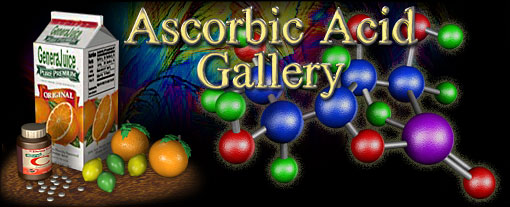
|
|
Vitamin C Image Number 1 - Vitamin C is perhaps the most popular vitamin among the common nutrients and biochemicals. Because the vitamin is water-soluble, it must be regularly replenished and is commonly found in fresh fruits, especially in the citrus family that is dominated by oranges, lemons, limes, and tangerines. Vitamin C (commonly referred to as ascorbic acid) is also abundant in green leafy vegetables. Vitamin C Image Number 2 - Collectively, vitamins assist in the formation of a wide spectrum of biochemicals including hormones, enzymes, proteins, neurotransmitters, and the genetic materials RNA and DNA. This image was made with purified vitamin C recrystallized from a melted slurry of solid powder. Vitamin C Image Number 3 - Soluble ascorbic acid is contained in the watery parts of fruits and vegetables and represents one of the least chemically stable molecules in the vitamin family. This weak acid is easily destroyed by mild alkali solutions such as baking soda. Once ingested, vitamin C is readily absorbed by the intestines and continues its journey through the watery components tissues that make up the human body, helping to build collagen protein while doubling as an antioxidant along the way. Vitamin C Image Number 4 - In its natural state, ascorbic acid appears in the form of a white to yellowish crystal or powder. The chemical name ascorbic acid refers to L-ascorbic acid, the levorotatory isomer, and has been widely synthesized as a supplement or food additive. Vitamin C Image Number 5 - Scurvy is a condition manifested by inadequate amounts of vitamin C in the diet, and the symptoms include swollen gums, loose teeth, black-and-blue spots or open sores on the skin, and slow wound healing. The disease was especially prevalent in seamen on long sea voyages during the sixteenth and seventeenth centuries who primarily ate nonperishable foods that lacked this essential vitamin. Vitamin C Image Number 6 - Although there is no question that the biochemical is essential to life, scientists are in considerable debate over the extent of vitamin C's influence into such areas as lowering blood cholesterol, combating viruses and the common cold, and protecting against cancer-causing agents. Vitamin C Image Number 7 - Some plants and animals are able to produce their own ascorbic acid because they have a cascade of enzymes that can transform glucose into ascorbic acid when needed. Interestingly, somewhere in the chain of evolution, humans either lost or never developed the enzymes that that can manufacture vitamin C, and therefore are dependent on dietary intake of ascorbic acid. Vitamin C Image Number 8 - Ascorbic acid is a relatively fragile molecule and it may be lost from foods during preparation, cooking, and/or storage. In spite of the fact that vitamin C is easily destroyed, it has the ability to preserve foods by virtue of its role as a reducing agent. Vitamin C Image Number 9 - Many plants and most animals, including reptiles, do not need to consume ascorbic acid rich foods and are instead genetically programmed to produce enzymes that convert glucose into vitamin C. Mammals, in particular, possess the L-gulonolactone oxidase enzyme, enabling them to manufacture ascorbic acid from blood glucose in a metabolic cascade of enzymatic action. Curiously, however, the only way that humans, guinea pigs, and several primate species can satisfy their ascorbic acid requirements is to obtain the vitamin in their diets. As it happens, although humans have three essential enzymes required to convert glucose into ascorbic acid, they lack the fourth and final enzyme needed to complete the biochemical pathway. Vitamin C Image Number 10 - Some scientists believe that naturally occurring bioflavinoids increase the influence of ascorbic acid on good health. Flavinoids are, in essence, plant pigments largely responsible for the colors of many fruits and vegetables containing large quantities of vitamin C. Vitamin C Image Number 11 - Increasing interest in nutritional supplements and fortified foods has led to maximum intake indicators, which provide general guidance about possible toxic levels to healthy people in specific groupings of gender and age, called the Tolerable Upper Intake Level or ULs. Food labels termed the Nutrition Facts Panel, mandatory on all processed foodstuffs, must highlight a product's content of ascorbic acid and other vitamins. Questions or comments? Send us an email.© 1995-2025 by Michael W. Davidson and The Florida State University. All Rights Reserved. No images, graphics, software, scripts, or applets may be reproduced or used in any manner without permission from the copyright holders. Use of this website means you agree to all of the Legal Terms and Conditions set forth by the owners.
This website is maintained by our
|